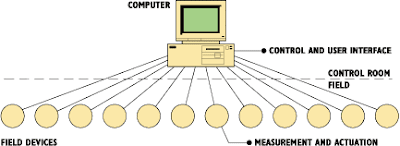Introduction of Micro Processor based Smart Sensors for Process Instrumentation. (1980)
Introduction of Centralized Computers for Process Instrumentation. (1970)
Electronic Analog Signal Standard 4-20 mA was introduced for Process Instrumentation. (1960)
Process Instrumentation based on Pneumatic Signal of 3-15 psi. (1940).
Introduction to Fieldbus
Fieldbus History
In the 1940’s, process instrumentation relied upon pressure signals of 3-15 psi for the monitoring of control devices. In the 1960’s, the 4-20 mA analogue signal standard was introduced for instrumentation. Despite this standard, various signal levels were used to suit many instruments which were not designed to the standards specification. The development of digital processors in the 1970’s sparked the use of computers to monitor and control a system of instruments from a central point.
The specific nature of the tasks to be controlled called for instruments and control methods to be custom designed. In the 1980’s smart sensors began to be developed and implemented in a digital control, microprocessor environment.
This prompted the need to integrate the various types of digital instrumentation into field networks to optimize system performance. While the “if it works then use it” mentality progressed, it became obvious that a Fieldbus standard was required to formalize the control of smart instruments.
What is Foundation Fieldbus?
Fieldbus is a digital communications network which will is used in industry to replace the existing 4 – 20mA analogue signal.
The network has properties of digital 2) bi-directional 3) multi-drop 4) serial-bus.
Fieldbus is a generic-term which describes a new digital communications network which will be used in industry to replace the existing 4-20mA analogue signal. The network is a digital, bi-directional, multidrop, serial-bus, communications network used to link isolated field devices, such as controllers, transducers, actuators and sensors. Each field device has low cost computing power installed in it, making each device a ‘smart’ device.
Each device will be able to execute simple functions on it’s own such as diagnostic, control, and maintenance functions as well as providing bi-directional communication capabilities. With these devices not only will the engineer be able to access the field devices, but they are also able to communicate with other field devices.
In essence fieldbus will replace centralised control networks with distributed-control networks. Therefore fieldbus is much more than a replacement for the 4 – 20mA analogue standard.

Fieldbus Definition:
“Digital, bi-directional, multi-drop, self clocking data communication for process automation.”
New technology in the network era.
Plant-wide Network.
Office Automation and Departmental Computers…
Control System Local Area Networks.
Automation and Display Systems..
Fieldbus.
Factory Floor Instrumentation & Control Devices
You know we are experiencing an revolution of information exchange by networking (information super highway). Network is connecting everything in the world, … business, PCs, even humans. Fieldbus is one of this epoch-making technologies toward 21st century.
Why Fieldbus?
- Real need to exploit intelligent instrumentation.
- Fieldbus has ushered in a new generation of innovative automation system products that has helped users address business needs for quality, cost and regulatory improvement.
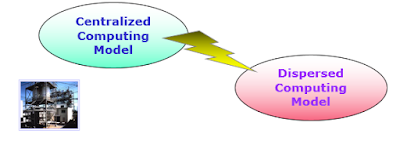
Fieldbus is characterized by:
- Completely digital replacement of 4-20 mA.
- Control, alarm, trend and other functions distributed to devices in the field.
- Interoperable multi-vendor support is possible.
- Open system; specification available without licensing agreement
Fieldbus is not only a new intelligent/smart transmitter protocol.
Fieldbus devices should not even be called smart devices, because that might mislead the user to believe that existing intelligent transmitters can do the same thing. Fieldbus is a complete system, with the control function distributed to equipment in the field, while still allowing operation and tuning from the control room using the digital communication. It replaces the traditional 4-20 mA and the classic DCS where the control function was centralized to one or more ‘control cards.
- To overcome the problems of smart transmitter protocols.
- Options for communication speed and device powering.
- Self operating Devices with a simple user interface.
- Automatic Address Assignment for Devices.
Fieldbus Requirements:
The main requirements for Fieldbus were to overcome the problems of smart transmitter protocols while maintaining the advantages of 4-20 mA standards (the main advantage of 4-20mA is tight closed loop control). By providing various options for communication speed and device powering, the requirements for both intrinsic safety and minimum communication delay can be met.
By optimization of network use, tight closed loop control can also be achieved where intrinsic safety is required. With 4-20 mA technology it is possible to build a control loop containing only a transmitter, a controller and an actuator. Fieldbus devices must also be capable of doing so, as well as acting in a larger control system. Fieldbus must be multipurpose and as versatile as 4-20 mA.
Fieldbus devices must therefore be able to operate by themselves with a simple user interface in order to be economical in small systems. The cost of a host computer with dedicated software. and certainly a DCS. cannot be justified for a small system, even though costs are going down. There would also be a logistics problem for both users and manufacturers if they were forced to keep using analog technology in small systems.
The possible complexity of a system where so many devices can be connected together (and where each device can perform the function of several conventional devices) requires a friendly user interface. The user must be freed from manual address assignment, as seen in smart transmitter protocols, and the painstaking job of tracking bits, bytes, words and memory addressees, as it is done in PLCs.
Foundation Fieldbus (FF) is globally accepted as prime Fieldbus technology for process plants.

In the days of “Analogue Instrumentation”, the components that made up the ‘system’ were “Supervisory Computers”, “Panel Mount Analog Controllers”, “Chart Recorders” and “Analog Field Instruments”.
Again, this is a classic example of the best technology available at the time. Improvements were made in terms of quality, increased output over the previously employed methodologies.
This is despite the fact that configuration, engineering and changes were difficult to make and expensive to implement.
Direct Digital Control System
Direct Digital Control (DDC) system — The first computerized system where control is centralized to a single computer in the control room. The control is centralized to a single computer in the control room.
Hybrid Instrumentation
•In 1975 with its first CENTUM, YOKOGAWA lead the world to migrate from Analogue Control to DCS control.
•The advent of DCS triggered the advancement of field instrument technology from “Analogue” to “Hybrid”. “Smart Instruments” provided their users with some benefits of “Digital Communication” such as easier maintenance and calibration, but still the measured variables used for “Control” remained “Analogue”.
Limited communications from intelligent field devices
• Condition based maintenance
• More Flexible & Controllable
• Plant operation via single window
• Limited communications from intelligent field devices
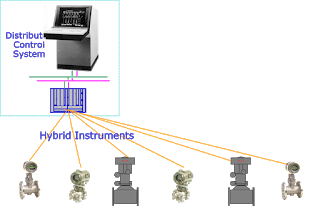
Distributed Control System (DCS) — The control partially distributed to a few control cards, still in the control room, each having several loops.
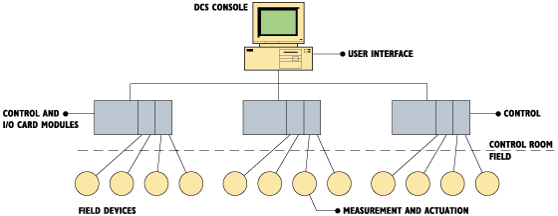
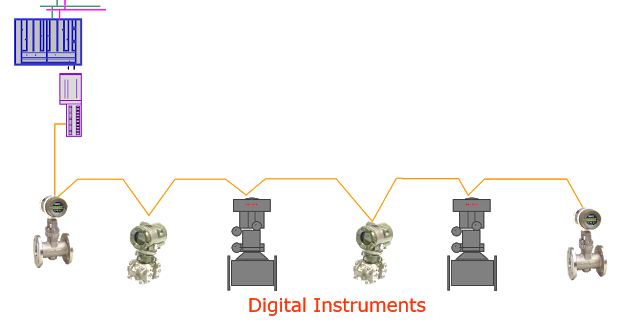
2-Way Digital Multi-drop communications
•Vendor independent, condition based maintenance, via single window.
• Enhanced process control functionality
• Additional control & Measurement functionality
• Reduced installation cost
• Interoperable
•Fieldbus will have an impact on not only field instrument technology but also on the entire control system architecture. It may take some time until all its influences will be evident as it took when DCS had taken over the conventional analogue controller.
Eventually, the control system architecture and technology will move toward the following directions:
• DCS: Move toward Open Architecture and Operation/Maintenance Center
•Field Instrument: Full Digital, Multi-variable and Self Verification
• Control: Distributed Full Digital Control either in the field OR in the DCS
•Fieldbus, like 4-20mA, is an enabling technology. It allows innovation to occur at all levels of a control system – from field devices to the supervisory automation systems.
Fieldbus will enable intelligent field device to provide operations with additional information beyond simply the process measurement value.
The actual or final results depend upon each application’s implementation providing innovation and solutions that benefit the entire organization. For example, the fieldbus specification from the Fieldbus Foundation allows for control functions to be implemented in field devices that may enable certain benefits if it is adopted.
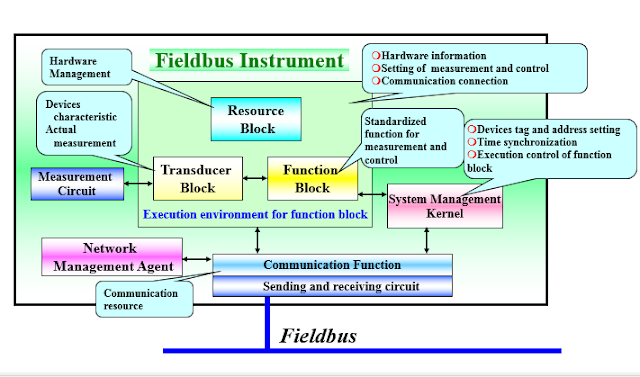
Digital Communication Advantages
Fieldbus is an interoperable multi-vendor protocol, which started as standardization work by ISA, the Instrumentation Society of America, just like the 4-20 mA standard. Fieldbus is expected to get worldwide recognition. All major instrument manufacturers have pledged their commitment to a single Fieldbus standard.
The approach was to establish the standard before commercial products were in place; as with most standards, it
looks as if that will not be the way. Some advantages of bi-directional digital communications, over 4-20 mA, and other good features are known from existing smart transmitter protocols:
•Higher accuracy and data reliability
•Multi-variable access
•Remote configuration and diagnostics
•Reduction of wiring
•Use existing ‘analog wiring’
Higher accuracy can be attributed to digital communication, since the microprocessors in, e.g., a transmitter and a controller may talk directly, rather than going through D/A and A/D conversions, of which there may be many in a closed loop. Status is passed along with measurement and control data. It is therefore possible to determine if the information is reliable or not. All data are checked and guaranteed free from distortion due to noise or an impedance mismatch that may affect analog undetected signals.
Multi-variable access, meaning, e.g., that a pressure transmitter is not limited to a single output for pressure, but also informs process temperature. Another example is access to setpoint and manipulated variable of a controller in the same device, or multiple channel inputs for a temperature transmitter.
The digital communication allows the complete configuration to be changed remotely. Calibration can be done in operation without having to apply any input or measure the output. Similarly, the status of the self diagnostics may
be interrogated.
Reduction in wiring and simplification is achieved through connection of several devices on a single pair of wires — multi-dropping.
Connection is a simple task, since everything is in parallel and terminal number matching is at a minimum. This means low cost and easy replacement of old transmitters. Some problems and disadvantages of existing protocols, in comparison to 4-20 mA technology, have also been seen:
•Communication speed too low for closed loop control
•Poor or no Interoperability between devices of different type and manufacturer.
•Devices must be polled for status
•Not interdevice
Fieldbus Advantages
- Initial Savings
- Reduction in wiring Cost.
- Maintenance Savings
- Maintenance becomes simpler as the Fieldbus system is less complex.
- Improved Systems Performance
System performance is enhanced due to the ability to communicate directly between two field devices rather than via the control system.
The major advantage of the fieldbus, and the one that is most attractive to the end user is its reduction in capital costs. The savings attained by the user stem from three main areas, initial savings, maintenance savings, and savings due to improved systems performance.
Initial Savings
One of the main features of the fieldbus is its significant reduction in wiring. Each process cell requires only one wire to be run to the main cable, with a varying number of cells available. The cost of installing field equipment in a fieldbus system is thus significantly reduced. Installation costs are further reduced due to the fact that the fieldbus it is a multi-drop rather than point-to-point system and the multidrop network can offer a 5:1 reduction in field wiring expense.
The fieldbus system requires less labour to install than conventional bus systems, and saves money due to a reduction in materials needed for the installation.
The simpler system design implies that fewer system drawings will be needed in order to develop a fieldbus system. This also has the advantage that the simpler design will result in less complex and faster bus systems.
Maintenance Savings
The fact that the fieldbus system is less complex than conventional bus systems implies that there will be less overall need for maintenance. The simplification of systems means that the long term reliability of the bus system is increased.
With the fieldbus system, it is possible for the operators to easily see all of the devices included in the system and to also easily interpret the interaction between the individual devices. This will make discovering the source of any problems and carrying out maintenance much simpler, and thus will reduce the overall debugging time.
The debugging and maintenance of the system will also be enhanced due to the fact that fieldbus enables online diagnostics to be carried out on individual field devices. The online diagnostics include functions such as open wire detection and predictive maintenance and simplify tasks such as device calibration.
Improved Systems Performance
Fieldbus allows the user increased flexibility in the design of the bus system. Some algorithms and control procedures that with conventional bus systems must be contained in control programs can now reside in the individual field devices, reducing the overall size of the main control system.
This reduces the overall systems cost and makes future expansion a simpler prospect. System performance is enhanced with the use of fieldbus technology due to the simplification of the collection of information from field devices. Measurement and device values will be available to all field and control devices in engineering units.
This eliminates the need to convert raw data into the required units and will free the control system for other more important tasks. The reduction in information complication will allow the development of better and more effective process control systems.
With fieldbus technology, two-way communication between field device and the control system is made possible. System performance is enhanced due to the ability to communicate directly between two field devices rather than via the control system. This also enables several related field devices to be combined into one device.
With fieldbus technology, field instruments can be calibrated, initialised, operated and repaired faster than most conventional analog instrumentation. this leads to an overall reduction in time required to operate the fieldbus system.
Other Advantages
As well as the cost advantages that fieldbus technology embodies, there are many other miscellaneous advantages that are included in the fieldbus package. Although it is a major challenge trying to develop a single worldwide protocol for process control, there are currently only two real protocols for fieldbus, being ISP and World FIP and while there is still two protocols rather than a world standard, it is better than a possible many.
Work is being done to merge the two protocols into a standard which will be a major advantage. The fact that eventually all fieldbus equipment will be standardised will mean that expansion of a system or addition of field devices will be extremely simple, requiring no interfaces or converters.
The fieldbus protocol involves only four layers and a set of management services. Fieldbus has the advantage that the user should not have to be concerned with the Data Link layer or the Application layer. As far as the end user is concerned, they should simply work. The user will only be required to have a limited knowledge of the management services, because some of the information generated by them will be needed if a problem occurs in the system. In fact, it should only be necessary for the user to concern themselves with the Physical and User layers.
Foundation Fieldbus allows innovation to occur at all levels of production management – from real time field operations to the production management level.
Greater accuracy
Fieldbus device from Field to the supervisory system does not require AD and DA conversions hence noise and errors are virtually eliminated.
Fewer devices
Fieldbus devices are Multi-variable and Multi-functional devices. This includes Test and Measurement devices, Power Measurement meters and Field Transmitters. These results in fewer devices to install and maintain.
Reduced wiring
Up to 32 devices can be connected to the same standard twisted pair cable, depending on the requirements such as powering, intrinsic safety and distance to be covered.
Some typical installation savings are:
Total cable -50%, cable trays -35%, field termination -60%, marshalling -100% and barriers -75%.
Ease of Maintenance
Condition based and predictive device maintenance and calibration functions of the field devices are available to the user via a single window. Start up and other activities can be done more efficiently via this single window.
Faster & Accurate Control
As the field devices in parallel more control functions can be processed, the control system. can be used to take care of more enhanced supervisory tasks thereby improving the process behavior.
Increase in Productivity
• Faster Device commissioning.
• Automated data collection .
• More efficient maintenance scheduling .
• Better utilization of process changeover and down time.
Better Quality
• More and accurate data for process analysis.
• Early warning of potential problems .
• Better device /process application match.
• Overall quality of cost is reduced.
Easier Compliance
• Improved data validity.
• Data tractability.
• More detailed data available.
• More comprehensive field coverage.
• Self contained data.
Turning to Fieldbus
• Higher reliability operation
• Virtually unlimited flexibility
• Reduction in equipment cost.
• Reduction in installation cost.
• Mass of information.
Benefits of Fieldbus
Foundation Fieldbus, like 4-20mA, is an enabling technology. However, Foundation Fieldbus allows innovation to occur at all levels of production management – from real time field operations to the production management level. Some of the main benefits, which can be achieved by utilising Foundation Fieldbus technology, are:
Greater accuracy: From the full digital field device up to the supervisory system no AD and DA conversions have to be performed and noise and errors are virtually eliminated. Digital sensors can be found today in our EJA pressure transmitter family as well as in our YEWFLO vortex flow meter family. Additional digital sensors are being developed
that maximise accuracy and enhance process plant performance.
Fewer devices are needed: Multi-variable and multi-functional devices including test and measurement devices, power measurement meters and our vast R&D resources develop specific IC’s. Combining technologies results in fewer devices to install and maintain. For instance temperature, flow, static pressure and density can all be measured by only one device. Due to Foundation Fieldbus technology, all this information can be made available.
Savings in maintenance and calibration efforts: Savings in maintenance time can vary from one up to several hours per instrument including documentation work. Examples are known in which 60 % of the traditional control valves were unnecessarily removed from the process for periodical maintenance.
The speed by which Fieldbus will capture the market depends largely on how fast the users are trained. One does not feel confident to buy something if one does not understand how it works. The simplicity of analog technology makes it easy to be understood. That is the main reason people feel so comfortable with it. 4-20 mA devices may be operated using only a screwdriver and tested with the most basic current meter.
Almost anybody could configure and troubleshoot such devices. Field devices may report failures and problems immediately, enabling maintenance personnel to pinpoint errors instantly or even before they can cause any harm. The multivariable capability of Fieldbus allows control, totalization and other signal processing in the field. Therefore, a separate controller or other signal conditioning equipment is not necessary. The host may be a simple off-the-shelf PC with MMI software. Multi-dropping of several devices on a single wire may drastically reduce the amount of needed cable. In many factories, a device can be a kilometer or even further away from the control room.
Since every loop needs at least two pairs of wires (one for the transmitter, the other for the actuator) a refinery can have several hundreds of such loops. In all, the cabling saving for a medium or large factory is immense. Transmitters and actuators are often located next to each other, but far from the operator console, an ideal situation for multi-dropping. Though prices of Fieldbus devices may initially be high, the reduction in number of devices and wiring, with associated cable trays and marshaling boxes, will yield a less expensive system. Manufacturers can no longer rely on proprietary technology to keep prices high. Fieldbus will bring open competition, which will eventually reduce prices.
Control Loop Connections
The Digital signal is super imposed on Analog Signal.
Pure Digital Communication using Single pair of wire for signal Transmission.
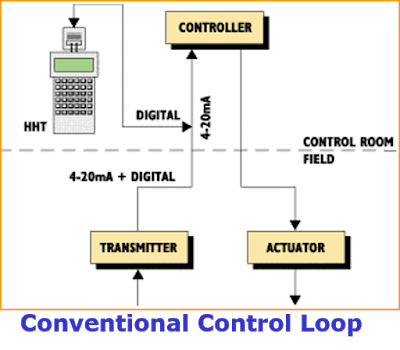
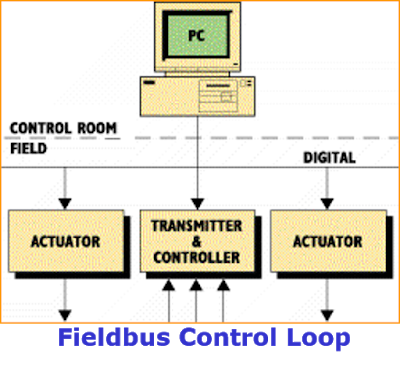
Conventional Control Loop
With intelligent/smart hybrid of analog and digital signal – individual variables involved in closed loop control have a physical 4-20 mA connection. Superimposed on it is a digital signal for configuration and diagnostics.
Fieldbus Control Loop
With Fieldbus pure digital communication — a single physical wire is the medium for multiple variables having logical connections.
Interoperability in FF
Definition:
Interoperability is the capability for a device from one manufacturer to interact with that of another manufacturer on a fieldbus network without loss of functionality.
The ability of 4-20 mA devices to replace any other device of the same type is called ‘interoperability’ roughly meaning compatible. Fieldbus offers the same capability. A brand ‘Y’ transmitter can be replaced by a brand ‘X’ transmitter of the same type any time, without loss of functionality, and can interface to another brand ‘Z’ device. Fieldbus forces interoperability between the devices, which are complying with this standard and it is also available to all manufacturers and users without licensing agreements. It is ‘open’, it is fully disclosed, there are no ‘secrets’.
The user or a third party can make their own configurations and software. Users may now select a device based on price, performance, quality and delivery time. They may mix and match the best of each type, just as they could with the 4-20 mA. They do not have to choose a device manufactured by a certain company just to match other devices of the same brand already installed (without Fieldbus, users would have been forced to develop special communication drivers in this case).
Another benefit of interoperability is that system software does not have to be upgraded when new products are introduced.
- Ability to substitute a field device from on manufacturer for that of another manufacturer without loss of functionality.
- Freedom to choose the right device for an application, independent of the supplier, control systems or protocol.
- The ability of the manufacturer to add new and useful features.
- Elimination of proprietary protocols and custom software drivers and upgrades
